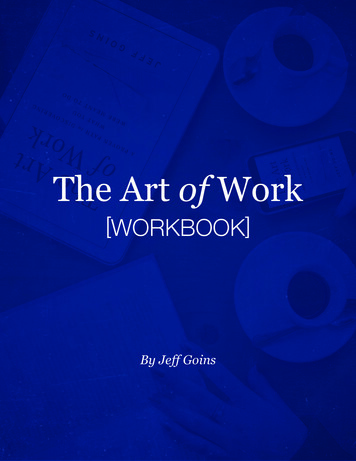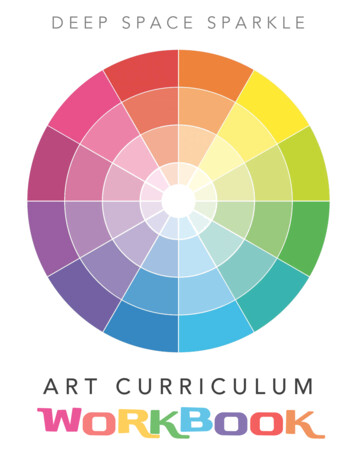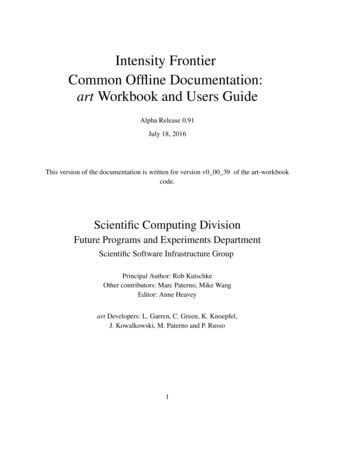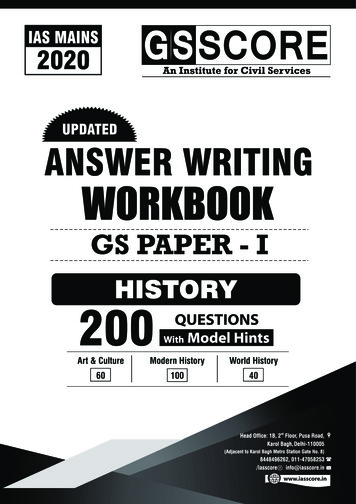
Transcription
The Art of Work[WORKBOOK]By Jeff Goins
The Art of Work[WORKBOOK]Note from the AuthorHi and thanks for downloading The Art of Work [WORKBOOK].This is a practical tool to help you get the most out of the bookand online course so that you can make sense of your life and findthe meaningful work you were meant to do.You are welcome to go through it by yourself or with a group.Enjoy!Thanks,Jeff Goins
The Art of Work[WORKBOOK]What You Need to NavigateThis Workbook A copy of the book, The Art of Work (the first part will referencespecific sections in the book). A willingness to work. A pen and paper (feel free to print this off and write on it).How to Use This WorkbookThis workbook is broken up into two parts.The first part is the action guide that will help you work throughthe book with a study group, another friend, or by yourself.The second part is the accompaniment to the complimentary fourpart video course you can find online at artofworkbook.com.Each part includes an overview, questions for discussion orreflection, and a practical action step. I recommend you print thisoff and work through it with pen and paper.
Part 1Action Guide
The Art of Work[WORKBOOK]IntroductionOverview: The story of Garrett Rush-Miller illustrates how a callingisn’t always something you can plan. In fact, how we respond towhat life throws at us is often what determines who we become.Questions: How has a negative circumstance in your life in someway led to a positive outcome? Do you think it’s true that how wereact to events determines who we become?Action: Make a list of the hardest obstacles in life that you’vehad to overcome so far. Identify what mindset had to do with theprocess. The biggest obstacle I ever faced:What it taught me was:My mindset at the time was:
The Art of Work[WORKBOOK]Notes
The Art of Work[WORKBOOK]Chapter 1Overview: The story of Jody Noland shows us how pain canawaken us to our purpose. It also shows us that our entire livesare speaking to us. Before you can tell your life what you want todo with it, you must listen to what it wants to do with you.Questions: When you look back at your life, is there a commontheme you can identify? Are the events of your life speaking toyou in some way? How could you respond?Action: Create a “listen to your life” timeline. On the next page,plot significant events in your life, including your first job, importantrelationships, even times when you moved.Significant Events
The Art of Work[WORKBOOK]Notes
The Art of Work[WORKBOOK]Chapter 2Overview: The story of Ginny Phang shows us how even whenwe feel alone, there are people to guide us. Every story of successis a story of community. Although mentors are hard to come by,accidental apprenticeships are everywhere. Your life is preparingyou for what’s to come.Questions: Are there people in your life who showed up at justthe right time? Can you look back and see your own accidentalapprenticeships? Who are the people in your life influencing youright now?Action: Design your apprenticeship. Don’t go in search of amentor; instead, identify the mentors that are already around you.On the next page, make a list of people who can be part of yourapprenticeship. For the ones you don’t know, find someone whodoes and ask for an introduction.Friends Who Can Encourage You
The Art of Work[WORKBOOK]Mentors Who Have DoneWhat You Want to Do Peers You Can Learn from
The Art of Work[WORKBOOK]Chapter 3Overview: The story of Stephanie Fisher shows how wecan sometimes practice the wrong things, whereas MartynChamberlin’s story illustrates how a calling can be something youmay not have considered. Practice is the way we not only getgood at something but discover whether or not we should bedoing it at all.Questions: How have you pursued the wrong thing in life? Haveyou ever succeeded in something that you weren’t passionateabout? Was there a time when you tried a new skill only to discoveryou were naturally gifted at something you didn’t know anythingabout?Action: Make a list of activities that could be your calling. Thenplace an “H” for hobby next to the ones you quit and a “V” forvocation next to the ones you didn’t. What does this tell you aboutyourself?Hobbies Versus Vocations
The Art of Work[WORKBOOK]Chapter 4Overview: The story of Ben and Kristy Carlson shows howsuccessfully pursuing a dream is less about taking a giant leapand more about building a bridge over time. You never “just know”what you’re supposed to do with your life. Discovery happens instages.Questions: How can you start building a bridge today that willlead to your calling? What’s one step you can take that will prepareyou for your future? What are the skills and knowledge you needto be ready for the work to come?Action: Identify discovery moments. Go back to that timeline youdrew or redraw it on the next page. When were you affirmed foran ability or skill you had? Plot out moments of discovery youexperienced when what you were supposed to do was more clearthan it was before.Discovery Moments
The Art of Work[WORKBOOK]Chapter 5Overview: The story of Matt McWilliams illustrates how failureisn’t always an enemy but can be an ally that helps us get closer toour life’s work. Don’t push through obstacles; pivot around them.Let every mistake and rejection teach you something. Before aseason of success, there often comes a season of failure.Questions: How has something that initially looked like failure toyou been the very thing you needed to succeed? What’s somethingyou feel like you’re failing at right now? What might that be tellingyou about your calling?Action: Identify the times when you faced an obstacle that forcedyou in a different direction. What did that tell you about yourself?Now, make a list of upcoming pivot points, changes you need tomake to create room for your calling.
The Art of Work[WORKBOOK]Pivot Points (Failures) Career Changes to Make
The Art of Work[WORKBOOK]Chapter 6Overview: The story of Jody Maberry shows how your vocationis more than just a job. It is a portfolio of meaningful work thatincludes every aspect of your life.Questions: What would your ideal portfolio look like? How muchwould you actually work, and what would you do with the restof your time? Is there an area of your life—work, home, play,purpose—that you’ve neglected?Action: Plan your portfolio. Instead of planning out your idealweek, focus instead on the next month. You have 30 days. Howmany do you need to work? How many days or hours are leftfor other activities? Go through the calendar and intentionally setaside time for home, play, purpose, and passion work that isn’tpart of your regular routine.Planning Your PortfolioWork:Play:Home:Purpose:
The Art of Work[WORKBOOK]Chapter 7Overview: The fictional account of Mr. Holland helps us see howthe difference we make can sometimes be taken for granted. Yourcalling is not just what you do; it’s the person you become—andthe legacy you leave.Questions: What is an example of a time when you werefocused on a task when you should have been focusing more onrelationships? If you were to have your own Mr. Holland moment,who would you want to be there to celebrate you?Action: Share the work. Begin by making a list of people you couldask to become a part of your team. These can be people you hirefor your business or organization, or it can be more informal likea monthly call or e-mail, sharing how you’re moving toward yourcalling. Also, identify what people in whom you want to personallyinvest.People Who Can Join You
The Art of Work[WORKBOOK]People to Keep Updated People You Can Mentor
The Art of Work[WORKBOOK]ConclusionOverview: Hemingway’s story is a picture of the inevitable regretwe face when we think our calling is just about the work. On thecontrast, Ed Cathey’s story is an illustration of how one man madea difference by investing in others.Questions: How could you be more intentional about sharingyour calling with others? What is the work that you will start butneed others to finish? Who can help you, and whom can youhelp?Action: Review all the workbook material, including the timelineand lists of people you can reach out to for help as well as thosewhom you can help. And get started creating your life’s worktoday.
The Art of Work[WORKBOOK]Notes
Part 2Mindset Shifts
The Art of Work[WORKBOOK]Mindset Shift #1:Let Go of ExpectationsOverview: Life isn’t always what we expect. But sometimes that’snot always a bad thing. We can end up with a life that is so muchbetter than we ever could have imagined. Living with expectationscan lead to three negative consequences: comparison, ingratitude,and apathy.Questions: How have expectations been holding you back?Where in your life have you seen comparison lead to ingratitudeand even apathy? How have some of the best things in your lifesurprised you?Action: List situations when your expectations were dashed.How did you feel? How did you respond? What good came ofthose situations?I expected:But this happened:And I learned:
The Art of Work[WORKBOOK]Current Expectations
The Art of Work[WORKBOOK]Mindset Shift #2:Embrace RealityOverview: The story of Eric and Garrett Miller teaches us somany lessons. In the last lesson, we discussed the mindset shift ofexpectations. In this lesson, we’re going to move into somethinga little different. We’re going to talk about embracing our reality.When we do this, it leads to uniqueness, gratitude, and action.Questions: How has embracing reality helped you move on fromdisappointment in the past? How do your weaknesses make youunique? How could you begin to see your current challenges asopportunities?Action: On the next page, list your limitations and brainstormhow these can, in fact, be strengths.
The Art of Work[WORKBOOK]My Limitations My Opportunities
The Art of Work[WORKBOOK]Mindset Shift #3:Decide What You WantOverview: You have the ability to respond to the things thathappen to you in spite of the odds and the challenges that lifethrows at you. You don’t have complete control, but at the sametime your path isn’t set in stone.Questions: Have there been times when life felt completely outof your control? What were they? What did you do? What couldyou have done?Action: Be honest about what you want out of life. Focus onthree areas: time, opportunity, and future. Use the next page towrite this down.I wish I had more time to:I wish I had the opportunity to:My ideal future would look like:
The Art of Work[WORKBOOK]Notes
The Art of Work[WORKBOOK]Mindset Shift #4:Do It AfraidOverview: Courage isn’t the absence of fear. It’s the willingnessto act in spite of that fear. We’re going to encounter all types offears in our life. Big ones. Little ones. If we acknowledge them, wecan learn to act anyway.Questions: How has fear stopped you dead in your tracks inthe past? What’re you currently afraid of, when it comes to yourvocation? What’s the worst thing that could happen? Is it as badas you imagine, or would you survive?Action: Recall a time in your life when the worst thing possiblehappened and how you got through it. On the next page, list yourcurrent fears. Think of your worst-case scenario. Be honest aboutwhat you can do and commit to doing something.My current fears are:The worst thing that could happen is:What I can control:
The Art of Work[WORKBOOK]Notes
Thanks!Thanks for going through The Art of Work [WORKBOOK]. I hope ithelped you gain more clarity about what you are meant to do withyour life and begin taking action.Feel free to share this workbook with a friend or group. It’scompletely copyright free. You can print and distribute as manycopies as you’d like. I just ask that you don’t change any of thecontent.I’d love to hear how this book and guide helped you. You canlet me know by joining the community on Facebook here:bit.ly/aowgroup.And if you liked this process, you’re going to love The Art of Workonline course. Find out more at artofworkbook.com.To you and the work you were meant to do,Jeff
The Art of Work [WORKBOOK] Note from the Author Hi and thanks for downloading The Art of Work [WORKBOOK]. This is a practical tool to help you get the most out of the book and online course so that you can make sense of your life and find the meaningful work you were meant to File Size: 653KBPage Count: 29










